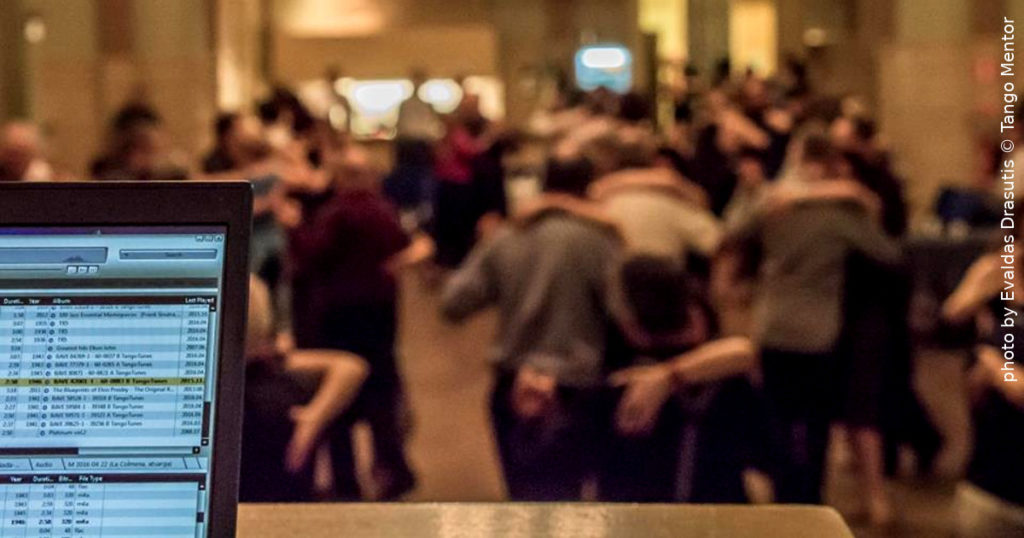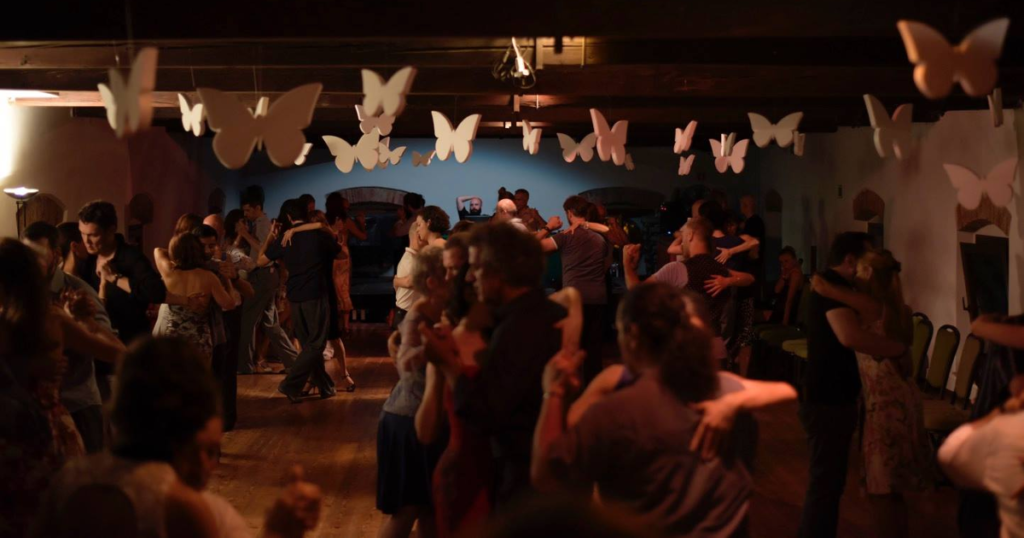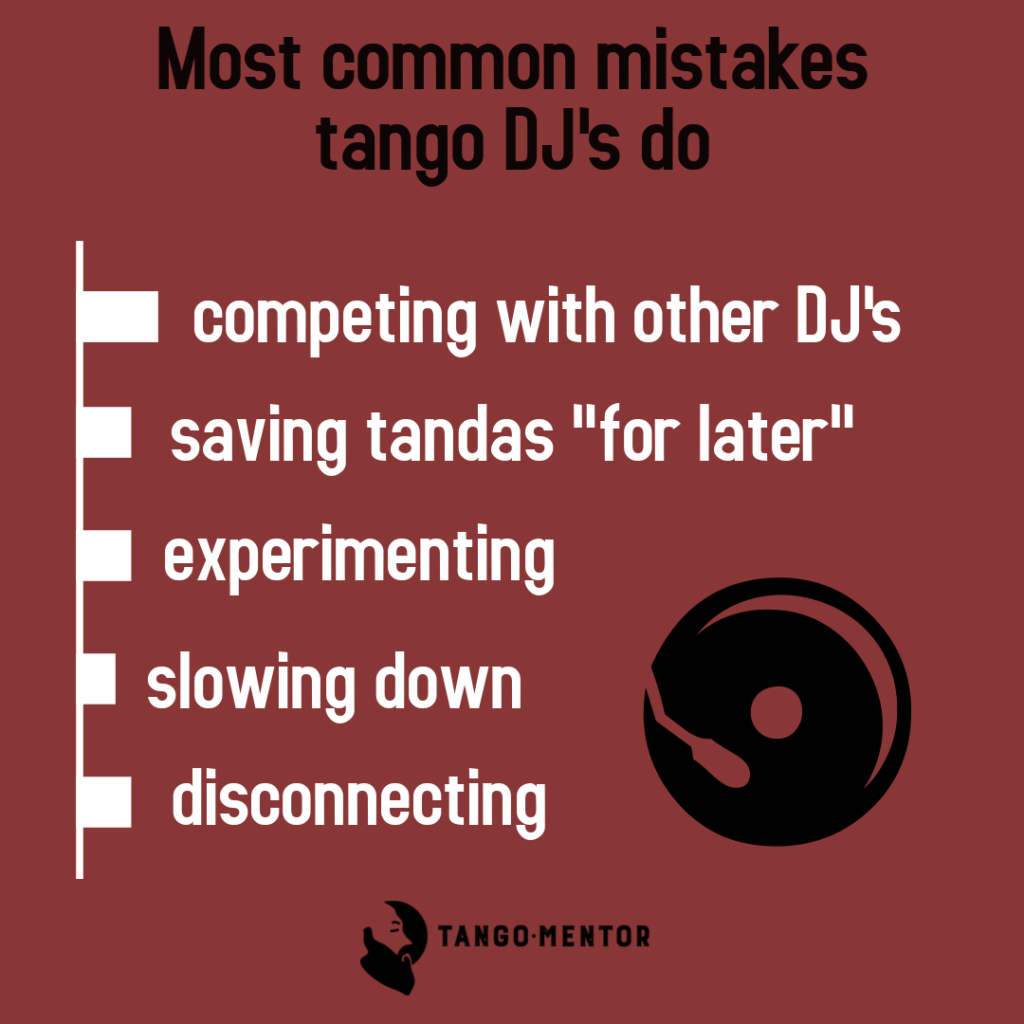
Becoming a good tango DJ takes time, energy and a lot of love for what you do; but your first steps don’t have to be that hard. In fact it’s much simpler than many people think it is.
Now, there are many ways to begin, but in my own experience these 5 steps are all you need to set yourself up to a great start. I am not promising you instant glory (although it’s not excluded), I just point out what you have to do to build a solid base.
In past few years I mentored and gave advice to many people. Some of them are rising stars DJs, some unfortunately gave up DJing and dancing due to personal reasons. From these experiences I can conclude that in order to become a good DJ you need two basic ingredients: having a passion for it and having strategy. I can’t help you with the first one, but I can show with you how can you build your strategy and what to learn/do first.
I see sharing my experience and knowledge as an investment in the quality of the global tango community – even some of the people who will benefit from it will be (some already are) my own competition.
🙂
So, you decided to become tango DJ. You have your own laptop: what is your next move? Where you go from there?
Let’s start!
1. Consistency is everything
If you want to become a good DJ you need to play music at least two times a month. The more – the better.
This is your beginning and you need to talk to the organizer of your local milonga to have you as a part of his/her DJing team. If this isn’t an option, think on organizing your own milonga – no matter how small it is, it is a place where you’ll learn the basics.
Hey, sorry to interrupt…
Do you like reading my articles? If you do please consider a small contribution to the existence of this blog.
I don’t sell a book or run ads: I share these articles for free. Unfortunately I also have to pay my bills, so if you see value in my work please consider a small donation/gratuity (the same way you tip your favorite bartender).
From my heart to yours!
Ivica
Securely processed via PayPal
2. Building your collection
There are many options how to build your music library: from the most simple one – to download it from internet for free; to exchange music with friends and other DJs; to buying collections on-line, or even to travel to Buenos Aires and buy it there.
This article is mostly meant to help beginners. This is why I’m giving you here a list of 15 orchestras every beginner must have. Please pay attention to choose music which is recorded between 1930 and 1950.
The reason is simple – the music from this period and these orchestras is mostly danceable and you can’t make mistake using it. Check out my article on danceability ON THIS LINK.
Now, here’s the list of must-have orchestras:
- Adolfo Carabelli
- Angel D’Agostino
- Anibal Troilo (with Francisco Fiorentino)
- Carlos Di Sarli (with Alberto Podesta, Ernesto Fama or Roberto Rufino)
- Edgardo Donato
- Enrique Rodriguez
- Francisco Canaro (with Ernesto Fama or Roberto Maida)
- Juan D’Arienzo (with Alberto Echague or Hector Maure)
- Miguel Calo (with Raul Beron or Raul Iriarte)
- Orquesta Tipica Victor
- Osvaldo Fresedo (with Ricardo Ruiz or Roberto Ray)
- Osvaldo Pugliese (with Roberto Chanel)
- Pedro Laurenz
- Ricardo Tanturi (with Enrique Campos)
- Rodolfo Biagi (with Jorge Ortiz)
Of course this is just the beginning: in time you’ll discover much more. My recommendation is to start your collection focusing on these orchestras with the mentioned singers.
Another important thing when you start is to have few key information:
- the name of the track
- the name of the orchestra
- the name of the singer/s
- the year it was recorded
Over the years I’ve seen many organizational systems. Some DJ’s are unorganized and play by instinct – others are meticulously obsessed to have every piece of info about their music. I’ve seen collections with details like where the track was purchased and with the names of every single event it was played at.
I find both extremes bad. My approach is to take care of some basic info and focus your attention on other, more important things. Here’s how I do it – just find the mentioned info about the track and rename the file or the tags in this way (I change the filenames):
<orchestra> (<singer>) – <year> – <song>
For example, using this format on the song “Abandonada” the filename will look like this:
Francisco Canaro (Ernesto Fama) – 1939 – Abanadonada.mp3
You can of course use tagging system which, I guess, is what it exists for – but I started this way and I ques it’s now a matter of habit. Many music players have in-build tag editors, but there are also many standalone tag editors out there – just make a quick search and you’ll find one that suits you.
3. Tandas for beginners
Don’t try to have every piece of music you can lay your hands on. When you start it’s enough to have just 4 songs from every orchestra listed above: 4 tangos, 3 milongas or 3 valses.
Quantity is nothing – focus on the quality of your choices.
I don’t mean the quality of the sound (although that also matters), but the quality of your selection. If you’re not sure what’s good choice pay attention which songs are well accepted by the dancers at your milongas, and also read a bit about orchestras on Todotango – the articles usually mention the most popular songs they recorded. You might also want to check my article “Am I a good DJ?”.
Now, I usually create a folder and copy the songs which I will play together, and I name it as I feel about it – “D’Arienzo – the best tango tanda” for example.
All orchestra should have few of these pre-created tandas. Have in mind that the best approach is to pay attention all of the songs to be with the same singer and were recorded in approximately same time.
For your first set you will need no more than one tanda for every orchestra. One tanda is approximately 12 minutes. If you have 15 orchestras listed above that’s 15 tandas – and you already have a set for more than 3 hours the usual time of a small local milonga.
When you start avoid experimenting with other orchestras – if you need more tandas, create another one from those orchestras, just using another orchestra/singer combination.
4. Killer cortinas
I know it might seem funny, but sometimes the cortinas can create better atmosphere than tango music itself. That’s why it’s best for you to pay attention to have energizing and non piano or violin based music as cortinas.
I recommend you to have consistency with the cortinas as well – do not experiment with different genres of music at the same milonga.
I also recommend you to use pre-created cortinas. Make them around 1 minute each and don’t forget to add some fade in in the beginning and, more importantly, a fade out at the end – since that reminds dancers that the cortina is soon to be finished and they should find a partner. One good tool to use to create cortinas is Audacity. It is free open source music editor, and, what is most important, it is very simple to use.
5. Structure your milonga
As a first step you have to learn the basic structure of the tango DJing set. I assume you already know this – but just in case here it is how you should order your tandas:
tango → tango → vals → tango → tango → milonga → tango → tango → vals →…
Tango tandas have 4 songs, milonga and vals tandas have 3 songs. If you have DJing set of 15 tandas, you will have to play approximately 10 tango tandas, and 2 vals and 1 milonga tandas (or vice versa).
Don’t forget to always announce the last tanda and finish the milonga with “La Cumparsita”!
I want to give you here a few recommendations about milonga and vals tandas – since they are specific I recommend you as a beginner to stick to some of these combinations.
Valses:
- Alfredo De Angelis (with Carlos Dante and/or Julio Martel)
- Juan D’Arienzo
- Rodolfo Biagi
Milongas:
- Francisco Canaro (with Roberto Maida)
- Edgardo Donato
- Juan D’Arienzo
I know that many will have to add a lot to this instant guide – I missed out many important things in order to make it short and clear. My intention was to motivate the beginners to take their first step, not to think about how much more lays ahead.
If you have something to add I will appreciate if you add it as a comment to this post.
Don’t forget to share the article with your aspiring tango DJ friends.


